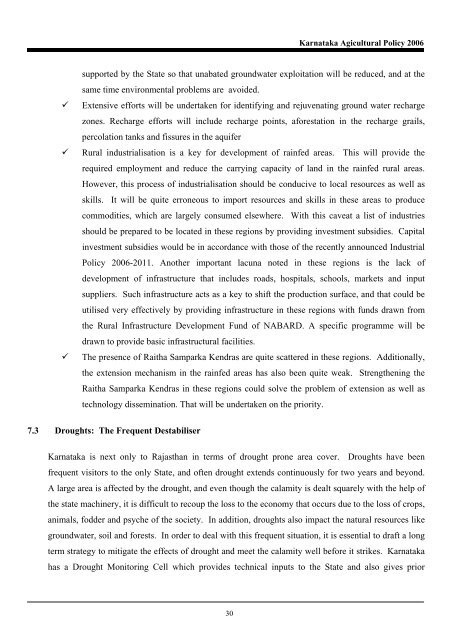Karnataka Agricultural Policy - Institute for Social and Economic ...
Karnataka Agricultural Policy - Institute for Social and Economic ...
Karnataka Agricultural Policy - Institute for Social and Economic ...
Create successful ePaper yourself
Turn your PDF publications into a flip-book with our unique Google optimized e-Paper software.
<strong>Karnataka</strong> Agicultural <strong>Policy</strong> 2006<br />
<br />
<br />
<br />
supported by the State so that unabated groundwater exploitation will be reduced, <strong>and</strong> at the<br />
same time environmental problems are avoided.<br />
Extensive ef<strong>for</strong>ts will be undertaken <strong>for</strong> identifying <strong>and</strong> rejuvenating ground water recharge<br />
zones. Recharge ef<strong>for</strong>ts will include recharge points, a<strong>for</strong>estation in the recharge grails,<br />
percolation tanks <strong>and</strong> fissures in the aquifer<br />
Rural industrialisation is a key <strong>for</strong> development of rainfed areas. This will provide the<br />
required employment <strong>and</strong> reduce the carrying capacity of l<strong>and</strong> in the rainfed rural areas.<br />
However, this process of industrialisation should be conducive to local resources as well as<br />
skills. It will be quite erroneous to import resources <strong>and</strong> skills in these areas to produce<br />
commodities, which are largely consumed elsewhere. With this caveat a list of industries<br />
should be prepared to be located in these regions by providing investment subsidies. Capital<br />
investment subsidies would be in accordance with those of the recently announced Industrial<br />
<strong>Policy</strong> 2006-2011. Another important lacuna noted in these regions is the lack of<br />
development of infrastructure that includes roads, hospitals, schools, markets <strong>and</strong> input<br />
suppliers. Such infrastructure acts as a key to shift the production surface, <strong>and</strong> that could be<br />
utilised very effectively by providing infrastructure in these regions with funds drawn from<br />
the Rural Infrastructure Development Fund of NABARD. A specific programme will be<br />
drawn to provide basic infrastructural facilities.<br />
The presence of Raitha Samparka Kendras are quite scattered in these regions. Additionally,<br />
the extension mechanism in the rainfed areas has also been quite weak. Strengthening the<br />
Raitha Samparka Kendras in these regions could solve the problem of extension as well as<br />
technology dissemination. That will be undertaken on the priority.<br />
7.3 Droughts: The Frequent Destabiliser<br />
<strong>Karnataka</strong> is next only to Rajasthan in terms of drought prone area cover. Droughts have been<br />
frequent visitors to the only State, <strong>and</strong> often drought extends continuously <strong>for</strong> two years <strong>and</strong> beyond.<br />
A large area is affected by the drought, <strong>and</strong> even though the calamity is dealt squarely with the help of<br />
the state machinery, it is difficult to recoup the loss to the economy that occurs due to the loss of crops,<br />
animals, fodder <strong>and</strong> psyche of the society. In addition, droughts also impact the natural resources like<br />
groundwater, soil <strong>and</strong> <strong>for</strong>ests. In order to deal with this frequent situation, it is essential to draft a long<br />
term strategy to mitigate the effects of drought <strong>and</strong> meet the calamity well be<strong>for</strong>e it strikes. <strong>Karnataka</strong><br />
has a Drought Monitoring Cell which provides technical inputs to the State <strong>and</strong> also gives prior<br />
30

















